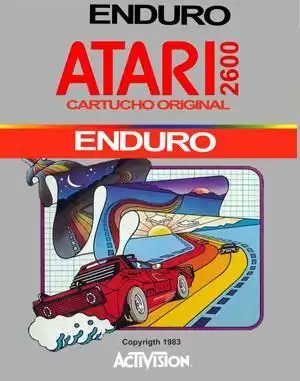Hitting the gas on the Atari 2600 often meant simple, blocky graphics and straightforward gameplay. But then came games like Enduro Atari 2600, which felt like a genuine leap forward, offering a surprisingly deep and engaging racing experience that captured the imagination of a generation of gamers. Released by Activision in 1983, Enduro wasn't just about getting from point A to point B; it was an endurance race, a test of skill and concentration against the clock, traffic, and even the elements.
For many, Enduro is the definitive racing game on the Atari 2600. It managed to squeeze impressive features into the console's limited hardware, creating a sense of a living, changing world rarely seen at the time.
What Made Enduro Feel So Real?
Unlike many contemporary racers that featured static tracks or simple point-to-point dashes, Enduro Atari 2600 introduced dynamic elements that made each "day" of the race feel unique.
- Day-Night Cycle: The most striking feature was the transition from bright daylight to dusk, then challenging nighttime where you could only see the taillights of competitors, and finally back to dawn. This wasn't just cosmetic; visibility dramatically impacted gameplay.
- Changing Weather & Conditions: As you progressed through the multi-day race, you might encounter fog, reducing visibility further, or icy patches that made steering treacherous. These variations added a layer of strategy and unpredictability.
- An Endless Road: While the graphics were simple, the game created a convincing illusion of a continuously scrolling road with changing landscapes, keeping the visual experience from becoming monotonous over long play sessions.
These features, powered by clever programming within a tiny 4KB ROM chip, made Enduro feel incredibly advanced for its time and platform.
The Thrill of the Race: Gameplay Basics
The premise of Enduro Atari 2600 is simple: survive. You're competing in the "National Enduro," a multi-day endurance race. To qualify for the next day, you need to pass a specific number of cars within the time limit (200 on the first day, 300 on subsequent days).
- Passing is Key: Your primary goal is to weave through traffic, overtaking opponent cars without colliding. Collisions slow you down significantly, potentially costing you precious time needed to meet the passing quota.
- Odometer Tracking: A simple odometer tracks how many cars you've passed, adding a clear visual indicator of your progress towards the day's goal.
- Increasing Difficulty: As days wear on, the AI drivers become faster and more aggressive, making it harder to navigate the increasingly dense traffic.
Survive five full days, and you earned an on-screen trophy. Gamers who proved this feat to Activision back in the day could even receive a physical "Activision Roadbuster" patch – a coveted badge of honor!
Behind the Wheel: Development & Release
Enduro Atari 2600 was designed by Larry Miller, a talented programmer who previously worked on other Activision hits like Spider Fighter. Miller was inspired by his own experiences driving through varied California landscapes and aimed to create a "realistic driving game" on the 2600.
He developed the game rapidly, reportedly in just three months, working long hours. The technical constraints of the Atari 2600 were immense, but Miller prioritized key visual elements like curving roads and distant mountains, which were challenging to implement but crucial for creating the game's sense of depth and speed.
Released in May 1983, Enduro was an immediate commercial success. It quickly climbed the charts, becoming a top seller and receiving widespread critical acclaim. Reviewers praised its innovative gameplay, impressive graphics for the system, and addictive nature, often calling it the best racing game available on the 2600.
Still Racing Today: Enduro's Legacy
Enduro Atari 2600 remains a beloved classic in the retro gaming community. Its innovative features and engaging gameplay have stood the test of time, proving that graphical simplicity doesn't mean a lack of depth or fun.
- Compilations: Enduro has been featured in various retro game compilations, including the Activision Anthology (available on platforms like GOG.com) and even as a hidden Easter egg in Call of Duty: Black Ops Cold War.
- Emulation: Thanks to projects like Archive.org, you can often find ways to play Enduro and other classic Atari 2600 games through browser-based emulation, allowing a new generation to experience this piece of gaming history.
- Influence: While not a direct sequel, Larry Miller's later game, The Great American Cross-Country Road Race (1985), built upon Enduro's core ideas with enhanced visuals and gameplay for home computers.
Enduro's legacy is secure as a prime example of how clever design and programming could push the boundaries of early console hardware, delivering memorable experiences that resonate decades later.
Enduro Atari 2600: Quick FAQ
Q: Who developed Enduro for the Atari 2600? A: Enduro was developed by Larry Miller and published by Activision.
Q: What was the main goal in Enduro? A: The goal was to survive each day of the endurance race by passing a required number of competitor cars (200 on day 1, 300 subsequently) before time ran out.
Q: Did Enduro have different weather conditions? A: Yes, the game featured dynamic weather effects like fog and icy patches, along with a full day-night cycle, which affected visibility and handling.
Q: Can I play Enduro on modern systems? A: Yes, Enduro is available in compilations like Activision Anthology (found on digital stores like GOG) and can often be played via Atari 2600 emulators found on sites like Archive.org.
Conclusion
Looking back at Enduro Atari 2600, it's easy to see why it holds such a special place in the hearts of retro gamers. It took the simple concept of a racing game and added layers of complexity and realism that were groundbreaking for the era. The ever-changing conditions, the tension of passing cars at night, and the satisfaction of qualifying for another day created an addictive loop that kept players coming back. Enduro wasn't just a game; it was an endurance challenge that proved the Atari 2600 still had plenty of tricks up its sleeve. It remains a shining example of classic Activision innovation.


